Budget is kind of a blueprint of the government on how they will be spending expenditure, taxes it plans to levy, and other transactions which has a huge effect on the economy and lives of citizens. According to the constitution of India, Article 112, the Union Budget of a year is referred to as the Annual Financial Statement (AFS). There are three major components in the budget system Expenditure, receipts and deficit indicators. The Budget Division of the Department of Economic Affairs in the Finance Ministry is the nodal body responsible for preparing the Budget.
The Budget was presented in the Parliament by the finance minister Nirmala Sitharaman on 1st February 2022 and addressed the concerns around growth, inflation and spending. While presenting the Budget, Nirmala Sitharaman announced that the country’s economic growth is expected to be at around 9.2 per cent in the current financial year. The Union Budget of 2022-2023 which is 39.45 trillion rupees will be focused on areas such as investment in infrastructure and digitalization. These steps are taken especially as the economy recovers from the Covid-19 pandemic. India has increased its expenditure for the year 2032 at Rs 7.5 lakh crore which is about 2.9% of the GDP. This increase is higher than the budget estimate of Rs 5.54 lakh crore in the finical year of 2022.
The Budget gave a big boost for infrastructure spending from the 5G spectrum auction, expanding national highways by 25,000 km, inter-linking of rivers and manufacturing of 400 new generation Vande Bharat trains. Some of the other highlights of the budget are as follows. The health sector overall sees a hike of 16% in budget but the reduction in the social sector has also raised concerns. There has been a rise on the duty for some of the products including, Headphones and earphones to 20% from 15%, Single or multiple loudspeakers to 20% from 15%, Smart meters to 25% from 15%, Solar cells to 25% from 20%, Solar modules to 40% from 20%, Sodium cyanide to 10% from 7.5% and Microbial fats and oils and their fractions to 100% from 30%. The MHA has also allocated Rs 35,581 cr for Jammu and Kashmir whereas the maximum amount to all the other UTs. The Department of Space has been allocated Rs 13,700 crore whereas the Tourism sector gets Rs 2400 cr in Budget. Also, Metro projects get Rs 19,130-crore in the Union budget.









